
Atlas F1 Technical Writer
The second round of the 2004 season provided the ten teams with the challenge of fighting against searing heat, reliability, engine changes, and driver mistakes. Atlas F1's technical writer Craig Scarborough reviews the cars and the technical changes seen through the weekend
As teams sought to counter the heat, the bodywork was opened up with the usual range of chimneys, grills and ducts, while the less prepared teams had to resort to cutting sections of bodywork away to release the heat built up within the sidepods. This need to cool the car increases drag, which costs top speed on the straights. Furthermore, those unplanned holes in the bodywork probably sacrificed some downforce as well, costing the car all the way around the lap.
This asymmetric set-up creates several issues for the designers, firstly requiring more space inside the sidepod to house both oil and water coolers. BAR and Sauber both have differently angled radiators left to right to accommodate this. Secondly, the heat rejection varies from the differing coolers; thus, more outlet space is required to vent the hotter oil/water sidepod. To this end many teams have larger outlets on the right hand side, with Williams running differing exhaust fairings and Ferrari having more slits in their grill outlets.
Malaysia's mix of straights and short tight corners usually sees the teams running lower drag/downforce set ups. This year, as the teams develop new solutions to regain lost rear downforce, a surprising amount of wing was seen on al the cars at Sepang. Moreover, as the teams did not return to their European factories between the two Asian-Pacific races, little visible development has taken place. Many teams have tweaked their transmission software to respond to the manual starts, first mandated for Australia.
Some of the secrets to teams' manual starts have been reported in the media, with Renault topping the "fast start" sheets. It is reported Renault drivers have a process that records the clutch biting point during the warm up lap and at the start of the race the clutch paddle is locked into this position, requiring the drivers only to release the clutch paddle (already at the optimum point) when the lights go out. It is possibly no coincidence that the FIA technical delegate subsequently undertook "Clutch and throttle operation data checks from the start period" and "Several gear shift data checks" on Fernando Alonso's car after the Malaysian race.
At the far end of the "fast starters" were Jaguar, who still have problems after Australia, which returned to spoil Mark Webber's front row start.
Tyres
Tyres were a critical factor at the start, and as with Melbourne, Ferrari were at the front of the grid and able to control the speed of the formation lap. So, Michael Schumacher was able to run the lap slower than the Michelin runners preferred. He was still able to get several "practice starts", all but stopping the car and releasing the clutch at high revs to both warm up the tyres and presumably log data to control the clutch release.
The warm up lap's pace was also symbolic of the tyre suppliers' comparative qualities. Michelin runners found their tyres were better in the opening laps of a stint, degrading towards the end, in a reverse to their behaviour in recent years. Meanwhile Bridgestone also displayed a reversal of performance, where their tyres worked best later in a stint. This lead the Bridgestones to be less effective over their opening laps, prompting Ferrari's low fuel qualifying and low speed warm up lap - both strategies aimed at countering Michelin's faster out-of-the-box pace.
Both suppliers found graining to be an issue with the front tyres, Michelin runners being particularly affected. If they tried to run too low a downforce setting, it required either more front wing - and in a poorer balance; or more rear wing as well, to provide balance at the cost of top speed.
As the weekend and the race wore on, changing conditions kept the teams on their toes, correcting front downforce to balance the car, and even during pitstops some teams revised front wing settings to reduce the graining. Bridgestone drivers had less of a problem but still needed to care for the tyres during the first five laps in order to reap the added grip in the later laps of a stint.
Aerodynamically, there has not been the chance or opportunity to ship large new pieces of bodywork to Malaysia. Nor has there been a large test program prior to the race, with McLaren exceptionally taking the chance to run test cars in Spain, to add miles to the new front wing and evaluate where problems occurred in Australia.
Team by Team
Ferrari
Arriving with Melbourne spec package, Ferrari still adopted the mid-wings over the roll structure. For cooling, the grills on the shoulders of the sidepods were opened up with more numerous and wider slits.
With Bridgestone having adopted tyres with Michelin-like response to heat, it was surprising the drivers split their tyre choice - with Michael Schumacher on a soft compound and Rubens Barrichello on the hard compound. However, had the race remained as hot as the temperatures experienced on Friday and Saturday, the benefit might have swung more towards Barrichello.
Opting to run heavy tanks early in the weekend and light tanks to qualify saw the teams' position on the time sheets jump up.
Williams
Visually indistinguishable from Melbourne, Williams displayed their usual management of the car's cooling requirements by only adopting slim chimneys on the sidepods, with the supplementary oil cooling provided by a larger fairing around the exhaust on one side only.
Throughout the weekend Williams were consistent in their chase of Ferrari and McLaren. Ralf Schumacher's weekend-long problems with graining were exacerbated in the race when he touched Mark Webber's rear tyre with his front wing, subtly affecting its geometry and requiring adjustments to wing angle during his Pitstops. Moreover, his fight with understeer was called to halt when his engine failed at half distance, on lap 28.
Juan Pablo Montoya's race pace was faster than Michael Schumacher's only in the early laps of each stint, when his tyres were optimum and Schumacher's were still wearing in. But overall his pace was close enough to suggest the gap in Melbourne was indeed a one off.
Renault
Key visible changes to the Renault were the fitment of the various cooling options catered for in the rear bodywork. While Renault was widely expected to suffer in the hot conditions, they did not in fact adopt all the possible apertures on the sidepods.
Pace was matched with reliability during Friday and Saturday's first qualifying session. Fernando Alonso's error and spin in the second timed session was the first for a top team under the new rules. So it was the first time teams were able to exercise their right to change an engine during the weekend. So an engine change was completed in 'Parc Ferme' late on Saturday, without any real loss in grid placings as Alonso was already at the back of the grid.
Curiously the FIA scrutineering statement quoted the replacement engine was without radiators or exhausts, which is surprising given that the engine wasn't replaced as a complete prepared unit.
BAR
Aside from the longer cooling aperture giving sight to the exhausts and radiators inside the sidepod, no other cooling ducts were fitted, and BAR have even yet to run outlet fairings around the exhaust system.
The early sessions of the weekend saw the team struggle with balance and the third car encountered the first of several engine problems for the team. Similar issues blighted qualifying, with Takuma Sato going off and the team taking the same route as Renault to switch the engine in Parc Ferme.
In post race scrutineering the FIA carried out several checks on Jenson Button's car, including a defection test of the front floor to ensure that the weight of the ballast located within the splitter does not allow any illegal flexing of the bodywork.
McLaren
After a self admitted disastrous Melbourne race, tests in Valencia brought the team some insight into their problems and allowed sufficient mileage to test the new front wing, so as to be able to use in Malaysia.
The new wing has a deep curve in its profile, akin to the format seen in the 2001/2002 seasons, used to regain lost front downforce. Also, a departure from both the original front wing and that seen on the MP4/18 was the use of drop plates (marked in orange on the drawing) to mount the wing remotely from the nose, the previous wings using the underside of the nose as part of the wing.
Comparing the two formats of the wings seen on the MP4/19 suggests the newer format wing could have more peak downforce at the cost of more pitch sensitivity. But if the team had encountered problems in either frontal aerodynamic grip or sensitivity during testing, then this new wing format would not appear to offer the answer.
Instead, perhaps sensitivity in roll could be a reason. As the car rolls, the dipped centre section would remain at a similar ride height and produce similar downforce. While in roll, the "W" format would see one of its two dipped sections rise and as the other falls, the former would be losing downforce as the other gains, moving the centre of pressure outwards, potentially unsettling the car.
Alternatively, the new wing debuted in testing with revised bargeboards, adding a third vane to the each side. It is possible the new wing represents a more fundamental change in flow around the car. The "W" format wing passes the turbulent flow from the two downforce-producing outer wing sections, around the outside of the bargeboards, well away from the centre of the car. This keeps the rest of the car in cleaner air but creates a larger overall cross section of turbulent air.
Teams such as Ferrari and Renault keep the flow from the middle of the wing much nearer to the car, using large rearward bargeboards and undercut sidepods, resulting in a tighter aerodynamic cross section. McLaren's move in this direction would need further work to bargeboards and sidepods to refine it, but with a "B" version of the car already planned for mid season, this could be a likely explanation.
From first practices the car showed much better pace, topping the time sheets on Friday. Qualifying did not go as well but the start of the race saw Kimi Raikonnen able to pass Barichello in the damp opening stint. Pitstops saw maladies start to creep in with poor getaways from all of the Finn's' stops, until his car retired with 16 laps to go. David Coulthard's car remained reliable to bring home points in sixth place.
Sauber
Sauber arrived with an unchanged car and well equipped for the heat, with only the usual grills on the sidepods and exhaust fairings being used. The car proved nervous if fast on the Bridgestone tyres, with Felipe Massa coping with the car better than Giancarlo Fisichella, who went several directions on set up. Qualifying brought the cars in at similar pace, while the race saw a spin for Massa in the damp segment and Fisichella's failing clutch delayed his pitstops.
Jaguar
Friday and Saturday were dream sessions for Mark Webber with a front row qualifying slot. The dream race ended straight away when the car barely limped off the grid at the start, pushing Webber far back into the midfield. The car's pace and Webber's forceful driving were such that he was able to regain places until his clashing with Ralf Schumacher lead to an almost full lap with a deflated rear tyre. He raced on after another pit visit for a drive by penalty, before losing the rear-end under braking and ending up in the gravel.
Christian Klien, on the other hand, pressed on and despite a delay with a fuel flap failure in one of his pitstops, the Austrian ended up a creditable tenth.
Toyota
Running with some new undisclosed aero parts, Toyota were happier with the car than in Melbourne. Yet, the practice sessions were still problematic and brought inexplicable handling difficulties for Olivier Panis in qualifying. In the race, understeer for both drivers was compounded by a radio communications failure for Panis, resulting in not one but redundant two drive throughs - once when he came in to find the team not ready for him, and the second when he served a penalty for speeded during his unscheduled pit visit.
Jordan
Friday saw the car difficult to drive with a mixture of understeer and oversteer. This continued into Saturday and was worsened by gearbox problems for Giorgio Pantano, who had to change to the T-Car which was not set up for him. He was able to return to his own car for the race, but from the pitlane, which only suffered drink-bottle problems.
Meanwhile, Nick Heidfeld suffered with fuel rig problems, forcing him to run a lap with too little fuel before returning to refuel with the spare rig. But his gear selection problems worsened, leaving him stuck in fifth and forced into retirement.
Minardi
No new major parts were raced and the cooling package remained the ever-present chimneys. Friday and Saturday sessions passed without drama and with a fair degree of balance for both drivers. Errors on qualifying laps cost some time, but as the rear of the grid was taken up by even more error-prone drivers, the last row eluded the team this time. Race day brought similarly clean reliable racing to prop up the back of the grid.
After the cooler conditions in Australia's season opener, Malaysia's heat came back to bite into the teams' reliability - the thermal effects of the weekend leading to several engine failures. The opening days of practice were held in extreme heat, while the race day brought lower temperatures and even some rain.
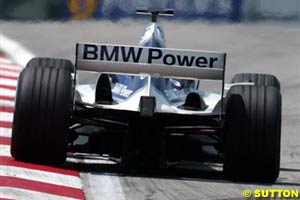 Engine reliability is governed by ambient temperature affecting engine temperatures, with oil temperature being principally important. Engines split their water cooling into separate left and right side circuits, each bank of cylinders having a dedicated pump and radiator. Meanwhile the oil circuit is common, with a single pump and radiator; this cooler is typically placed in the right hand sidepod.
Engine reliability is governed by ambient temperature affecting engine temperatures, with oil temperature being principally important. Engines split their water cooling into separate left and right side circuits, each bank of cylinders having a dedicated pump and radiator. Meanwhile the oil circuit is common, with a single pump and radiator; this cooler is typically placed in the right hand sidepod.
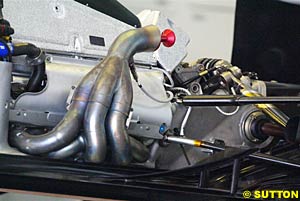 Williams have created a new format for their installation of the rear springs, dampers and linkages. Last year's car was a step way from the traditional coil spring layout used by Williams for many years. This year's car also adopts torsion bars pointed sharply downwards within the gear casing. These are operated as usual by the push rod acting on a primary rocker linkage, but instead of placing the dampers inside the gear casing, they are operated by a secondary rocker pivoted on the gear casing. This in turn operates the dampers and antiroll bar. To accommodate bump control, a large third coil spring damper is compressed between the primary rockers.
Williams have created a new format for their installation of the rear springs, dampers and linkages. Last year's car was a step way from the traditional coil spring layout used by Williams for many years. This year's car also adopts torsion bars pointed sharply downwards within the gear casing. These are operated as usual by the push rod acting on a primary rocker linkage, but instead of placing the dampers inside the gear casing, they are operated by a secondary rocker pivoted on the gear casing. This in turn operates the dampers and antiroll bar. To accommodate bump control, a large third coil spring damper is compressed between the primary rockers.
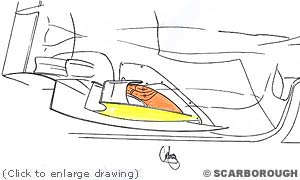 Following on from their competitive Melbourne race, BAR was the only team aside from McLaren with revised bodywork, albeit just a detail change to the endplate on the flip ups. The usually small shaped endplate mounting the winglet was replaced with a longer plate (marked in the drawing in yellow), reminiscent of the type Jordan have just discarded. Whether this was a performance enhancing part or part of the larger cooling aperture (marked in orange in the drawing) is not clear.
Following on from their competitive Melbourne race, BAR was the only team aside from McLaren with revised bodywork, albeit just a detail change to the endplate on the flip ups. The usually small shaped endplate mounting the winglet was replaced with a longer plate (marked in the drawing in yellow), reminiscent of the type Jordan have just discarded. Whether this was a performance enhancing part or part of the larger cooling aperture (marked in orange in the drawing) is not clear.
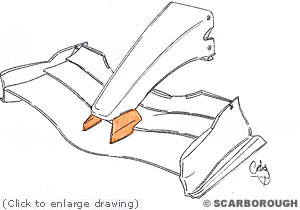 The new front wing appeared in testing just before the cars were shipped to Australia. Adrian Newey had never fully adopted the dipped centre section on the front wing; McLaren have largely remained with flatter wings, or the "W" format version seen on the un-raced MP4/18. But the team started to encounter problems with their car in January testing, co-incidentally as they first ran the 2004 spec rear wing.
The new front wing appeared in testing just before the cars were shipped to Australia. Adrian Newey had never fully adopted the dipped centre section on the front wing; McLaren have largely remained with flatter wings, or the "W" format version seen on the un-raced MP4/18. But the team started to encounter problems with their car in January testing, co-incidentally as they first ran the 2004 spec rear wing.
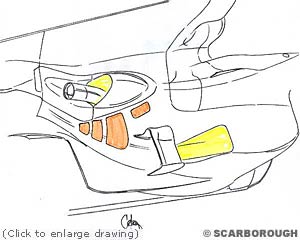 Aside from the front wing and complex endplates, McLaren were one of the teams forced to make holes in the sidepods for cooling. Large sections above the flip up (marked in the drawing in orange) were opened up and covered with mesh to allow air from the radiators to pass around the obstruction created by the exhausts.
Aside from the front wing and complex endplates, McLaren were one of the teams forced to make holes in the sidepods for cooling. Large sections above the flip up (marked in the drawing in orange) were opened up and covered with mesh to allow air from the radiators to pass around the obstruction created by the exhausts.
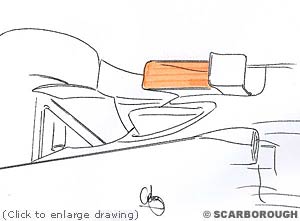 With testing between the races centred on improving the manual launch control, only the cooling set-ups were revised. Still adopting the large duct formed from the sidepods, the top of the duct was opened up all the way back to the winglet.
With testing between the races centred on improving the manual launch control, only the cooling set-ups were revised. Still adopting the large duct formed from the sidepods, the top of the duct was opened up all the way back to the winglet.
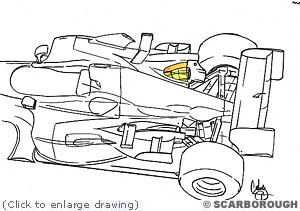 In order to cope with the heat, Jordan cut back the bodywork around the exhausts to create more outlet area (marked in the drawing in orange). This was in conjunction with slightly larger chimneys.
In order to cope with the heat, Jordan cut back the bodywork around the exhausts to create more outlet area (marked in the drawing in orange). This was in conjunction with slightly larger chimneys.
|
Contact the Author Contact the Editor |
Please Contact Us for permission to republish this or any other material from Atlas F1.
|
Volume 10, Issue 12
Atlas F1 Exclusive
The Business of Formula One 2004
Interview with Christian Klien
Bjorn Wirdheim: Going Places
Ann Bradshaw: Point of View
2004 Malaysian GP Review
2004 Malaysian GP Review
Technical Review: Malaysia
Buttoned Up
Stats Center
Qualifying Differentials
SuperStats
Charts Center
Columns
The F1 Insider
Season Strokes
On the Road
Elsewhere in Racing
The Weekly Grapevine
> Homepage |